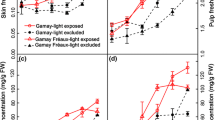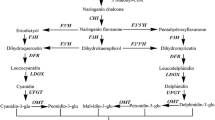Abstract
The mature berry of Vitis vinifera ‘Alicante Bouschet’ is entirely red, but anthocyanin metabolism discloses elements of histological discontinuity. This provides an experimental system amenable to studies of compartmentalised secondary metabolism in a fleshly fruit. We compared microscopy of fixed berry sections and chemical composition of anthocyanin extracts with the expression of 41 flavonoid genes in three berry tissues. In the pericarp, anthocyanins formed membrane-encased spherical coalescences that gradually enlarged and were shuttled into the vacuolar system. The size and the intensity of in situ pigmentation and of colour extracts of anthocyanin vesicles all decreased with depth beneath the epidermis. Shades of red colour, and the quantity and types of anthocyanins in skin, flesh, and seed extracts were correlated with differences in the expression of flavonoid 3′,5′-hydroxylases and anthocyanin genes encoding transcription factors, enzymatic proteins, and transporters. Fine adjustments in the global transcriptional modulation of the pathway occurred distinctively in each tissue, within four groups of co-expressed genes that were more associated with either the pericarp or the seed, and with either early or late-ripening stages. All structural genes controlling early steps of the flavonoid pathway exist in the grapevine genome in multiple copies that were recruited by antagonistic branches of the pathway in the ‘Alicante Bouschet’ berry. Expression patterns of individual paralogs were spatiotemporally distinct from one another, in step with either anthocyanin genes or proanthocyanidin genes.







Similar content being viewed by others
References
Alleweldt G, Engel M, Gebbing H (1981) Histologische untersuchungen an wienbeeren. Vitis 20:1–7
Bogs J, Downey MO, Harvey JS, Ashton AR, Tanner GJ, Robinson SP (2005) Proanthocyanidin synthesis and expression of genes encoding leucoanthocyanidin reductase and anthocyanidin reductase in developing grape berries and grapevine leaves. Plant Physiol 139:652–663
Bogs J, Jaffé FW, Takos AM, Walker AR, Robinson SP (2007) The grapevine transcription factor VvMYBPA1 regulates proanthocyanidin synthesis during fruit development. Plant Physiol 143:1347–1361
Carmona MJ, Chaïb J, Martínez-Zapater JM, Thomas MR (2008) A molecular genetic perspective of reproductive development in grapevine. J Exp Bot 59:2579–2596
Castellarin SD, Di Gaspero G (2007) Regulation of the anthocyanin biosynthetic pathway in naturally occurring extreme phenotypes for red berry colour of Vitis vinifera. BMC Plant Biol 7:46
Castellarin SD, Pfeiffer A, Sivilotti P, Degan M, Peterlunger E, Di Gaspero G (2007) Transcriptional regulation of anthocyanin biosynthesis in ripening fruits of grapevine under seasonal water deficit. Plant Cell Environ 30:1381–1399
Castellarin SD, Gambetta GA, Wada H, Shackel KA, Matthews MA (2011) Fruit ripening in Vitis vinifera: spatiotemporal relationships among turgor, sugar accumulation, and anthocyanin biosynthesis. J Exp Bot 62:4345–4354
Castillo-Muñoz N, Fernández-González M, Gómez-Alonso S, García-Romero E, Hermosín-Gutiérrez I (2009) Red-color related phenolic composition of Garnacha Tintorera (Vitis vinifera L.) grapes and red wines. J Agr Food Chem 57:7883–7891
Chaïb J, Torregrosa L, Mackenzie D, Corena P, Bouquet A, Thomas MR (2010) The grape microvine—a model system for rapid forward and reverse genetics of grapevines. Plant J 62:1083–1092
Conn S, Curtin C, Bézier A, Franco C, Zhang W (2008) Purification, molecular cloning, and characterization of glutathione S-transferases (GSTs) from pigmented Vitis vinifera L. cell suspension cultures as putative anthocyanin transport proteins. J Exp Bot 59:3621–3634
Conn S, Franco C, Zhang W (2010) Characterization of anthocyanic vacuolar inclusions in Vitis vinifera L. cell suspension cultures. Planta 231:1343–1360
Considine JA, Knox RB (1979) Development and histochemistry of the cells, cell wall, and cuticle of the dermal system of fruit of the grape, Vitis vinifera L. Protoplasma 99:347–365
Considine JA, Knox RB (1981) Tissue origins, cell lineages and patterns of cell division in the developing dermal system of the fruit of Vitis vinifera L. Planta 151:403–412
Coombe BG (1987) Distribution of solutes within the developing grape berry in relation to its morphology. Am J Enol Viticult 38:120–127
Cutanda-Perez MC, Ageorges A, Gomez C, Vialet S, Terrier N, Romieu C, Torregrosa L (2009) Ectopic expression of VlmybA1 in grapevine activates a narrow set of genes involved in anthocyanin synthesis and transport. Plant Mol Biol 69:633–648
Czemmel S, Stracke R, Weisshaar B, Cordon N, Harris NN, Walker AR, Robinson SP, Bogs J (2009) The grapevine R2R3-MYB transcription factor VvMYBF1 regulates flavonol synthesis in developing grape berries. Plant Physiol 151:1513–1530
Deluc L, Barrieu F, Marchive C, Lauvergeat V, Decendit A, Richard T, Carde JP, Mérillon JM, Hamdi S (2006) Characterization of a grapevine R2R3-MYB transcription factor that regulates the phenylpropanoid pathway. Plant Physiol 140:499–511
Deluc L, Bogs J, Walker AR, Ferrier T, Decendit A, Merillon JM, Robinson SP, Barrieu F (2008) The transcription factor VvMYB5b contributes to the regulation of anthocyanin and proanthocyanidin biosynthesis in developing grape berries. Plant Physiol 147:2041–2053
Espley RV, Hellens RP, Putterill J, Stevenson DE, Kutty-Amma S, Allan AC (2007) Red colouration in apple fruit is due to the activity of the MYB transcription factor, MdMYB10. Plant J 49:414–427
Falginella L, Castellarin SD, Testolin R, Gambetta GA, Morgante M, Di Gaspero G (2010) Expansion and subfunctionalisation of flavonoid 3′,5′-hydroxylases in the grapevine lineage. BMC Genomics 11:562
Gomez C, Terrier N, Torregrosa L, Vialet S, Fournier-Level A, Verriès C, Souquet JM, Mazauric JP, Klein M, Cheynier V, Ageorges A (2009) Grapevine MATE-type proteins act as vacuolar H+-dependent acylated anthocyanin transporters. Plant Physiol 150:402–415
Gomez C, Conejero G, Torregrosa L, Cheynier V, Terrier N, Ageorges A (2011) In vivo grapevine anthocyanin transport involves vesicle-mediated trafficking and the contribution of anthoMATE transporters and GST. Plant J 67:960–970
Goto-Yamamoto N, Wan GH, Masaki K, Kobayashi S (2002) Structure and transcription of three chalcone synthase genes of grapevine (Vitis vinifera). Plant Sci 162:867–872
Grimplet J, Deluc LG, Tillett RL, Wheatley MD, Schlauch KA, Cramer GR, Cushman JC (2007) Tissue-specific mRNA expression profiling in grape berry tissues. BMC Genomics 8:187
Grotewold E, Davies K (2008) Trafficking and sequestration of anthocyanins. Nat Prod Commun 3:1251–1258
Hardie WJ, O’Brien TP, Jaudzems VG (1996) Morphology, anatomy and development of the pericarp after anthesis in grape, Vitis vinifera L. Aust J Grape Wine R 2:97–142
He JJ, Liu YX, Pan QH, Cui XY, Duan CQ (2010) Different anthocyanin profiles of the skin and the pulp of Yan7 (Muscat Hamburg × Alicante Bouschet) grape berries. Molecules 15:1141–1153
Hichri I, Heppel SC, Pillet J, Léon C, Czemmel S, Delrot S, Lauvergeat V, Bogs J (2010) The basic helix-loop-helix transcription factor MYC1 is involved in the regulation of the flavonoid biosynthesis pathway in grapevine. Mol Plant 3:509–523
Hichri I, Barrieu F, Bogs J, Kappel C, Delrot S, Lauvergeat V (2011) Recent advances in the transcriptional regulation of the flavonoid biosynthetic pathway. J Exp Bot 62:2465–2483
Hugueney P, Provenzano S, Verriès C, Ferrandino A, Meudec E, Batelli G, Merdinoglu D, Cheynier V, Schubert A, Ageorges A (2009) A novel cation-dependent O-methyltransferase involved in anthocyanin methylation in grapevine. Plant Physiol 150:2057–2070
Iandolino AB, Goes da Silva FG, Lim H, Choi H, Williams LE, Cook DR (2004) High-quality RNA, cDNA, and derived EST libraries from grapevine (Vitis vinifera L.). Plant Mol Biol Rep 22:269–278
Jeong ST, Goto-Yamamoto N, Kobayashi S, Esaka M (2004) Effects of plant hormones and shading on the accumulation of anthocyanins and the expression of anthocyanin biosynthetic genes in grape berry skins. Plant Sci 167:247–252
Laitinen RA, Ainasoja M, Broholm SK, Teeri TH, Elomaa P (2008) Identification of target genes for a MYB-type anthocyanin regulator in Gerbera hybrida. J Exp Bot 59:3691–3703
Matus JT, Aquea F, Arce-Johnson P (2008) Analysis of the grape MYB R2R3 subfamily reveals expanded wine quality-related clades and conserved gene structure organization across Vitis and Arabidopsis genomes. BMC Plant Biol 8:83
Matus JT, Loyola R, Vega A, Peña-Neira A, Bordeu E, Arce-Johnson P, Alcalde JA (2009) Post-veraison sunlight exposure induces MYB-mediated transcriptional regulation of anthocyanin and flavonol synthesis in berry skins of Vitis vinifera. J Exp Bot 60:853–867
Matus JT, Poupin MJ, Cañón P, Bordeu E, Alcalde JA, Arce-Johnson P (2010) Isolation of WDR and bHLH genes related to flavonoid synthesis in grapevine (Vitis vinifera L.). Plant Mol Biol 72:607–620
Mizuno H, Hirano K, Okamoto G (2006) Effect of anthocyanin composition in grape skin on anthocyanic vacuolar inclusion development and skin coloration. Vitis 45:173–177
Nakamura M (1993) Anthocyanoplasts in Kyoho grapes. J Jap Soc Hortic Sci 62:353–358
Petroni K, Tonelli C (2011) Recent advances on the regulation of anthocyanin synthesis in reproductive organs. Plant Sci 181:219–229
Poustka F, Irani NG, Feller A, Lu Y, Pourcel L, Frame K, Grotewold E (2007) A trafficking pathway for anthocyanins overlaps with the endoplasmic reticulum-to-vacuole protein-sorting route in Arabidopsis and contributes to the formation of vacuolar inclusions. Plant Physiol 145:1323–1335
Pratt C (1971) Reproductive anatomy in cultivated grapes: a review. Am J Enol Viticult 22:92–109
Robinson J (2006) The Oxford companion to wine, 3rd edn. Oxford University Press, London, p 840
Santiago JL, González I, Gago P, Alonso-Villaverde V, Boso S, Martínez MC (2008) Identification of and relationships among a number of teinturier grapevines that expanded across Europe in the early 20th century. Aust J Grape Wine R 14:223–229
Sturn A, Quackenbush J, Trajanoski Z (2002) Genesis: cluster analysis of microarray data. Bioinformatics 18:207–208
Terrier N, Torregrosa L, Ageorges A, Vialet S, Verriès C, Cheynier V, Romieu C (2009) Ectopic expression of VvMybPA2 promotes proanthocyanidin biosynthesis in grapevine and suggests additional targets in the pathway. Plant Physiol 149:1028–1041
Thompson MM, Olmo HP (1963) Cytohistological studies of cytochimeric and tetraploid grapes. Am J Bot 50:901–906
Torregrosa L, Fernandez L, Bouquet A, Boursiquot J-M, Pelsy F, Martinez-Zapater J-M (2011) Origins and consequences of somatic variation in grapevine. In: Zapater MM, Adam-Blondon AF, Kole C (eds) Genetics, genomics and breeding of grapes. Sciences Publishers, Enfield, NH, pp 68–92
Walker AR, Lee E, Bogs J, McDavid DA, Thomas MR, Robinson SP (2007) White grapes arose through the mutation of two similar and adjacent regulatory genes. Plant J 49:772–785
Acknowledgments
The authors thank Carla Calligaro for preparation of berry sections, Ernesto Pascotto for assistance in microscope observations, Kaitlin McNally for technical work in expression analysis, Enrico Braidot and Enrico Peterlunger for HPLC analysis, Courtney Coleman for editing the manuscript, and Vivai Cooperativi Rauscedo for providing grape samples. This research was funded by the Regional Government of Friuli Venezia Giulia.
Author information
Authors and Affiliations
Corresponding author
Electronic supplementary material
Below is the link to the electronic supplementary material.
Rights and permissions
About this article
Cite this article
Falginella, L., Di Gaspero, G. & Castellarin, S.D. Expression of flavonoid genes in the red grape berry of ‘Alicante Bouschet’ varies with the histological distribution of anthocyanins and their chemical composition. Planta 236, 1037–1051 (2012). https://doi.org/10.1007/s00425-012-1658-2
Received:
Accepted:
Published:
Issue Date:
DOI: https://doi.org/10.1007/s00425-012-1658-2




